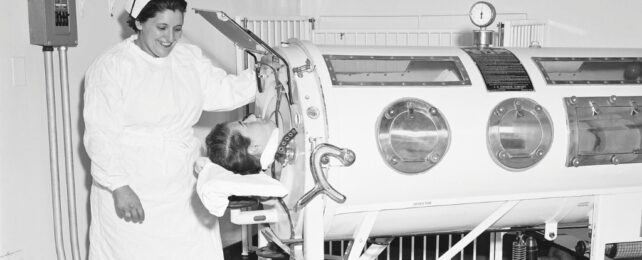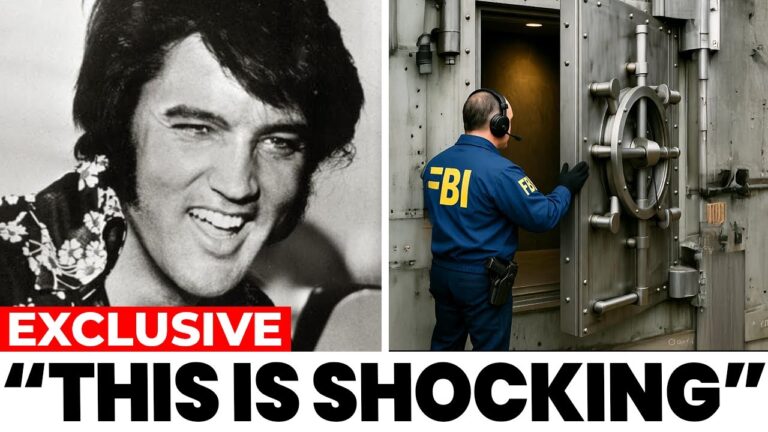In 1950, a haunting photograph captured a moment frozen in time. It showed children lying inside enormous machines known as “iron lungs.” These mechanical contraptions, a lifeline for those suffering from polio, were the only things standing between these children and death. Paralyzed by the disease, they relied on the iron lung to breathe. This photo serves as a stark reminder of a time when polio struck fear into the hearts of parents and communities around the world, a disease that paralyzed children and left them helpless in the face of a terrifying epidemic.
The children in the photograph were not just victims of a disease; they were symbols of the resilience of the human spirit, struggling to survive in a world that seemed to offer no hope. Yet, as history would unfold, the story of these children and the devastating disease that plagued them would take a sharp turn. What had once been a deadly, paralyzing disease was gradually eradicated, thanks to science, innovation, and the unwavering compassion of medical professionals.
The photo, while a somber reminder of the hardships faced by these children, is also a powerful symbol of human progress and triumph over adversity. It reflects the journey from fear and suffering to hope and healing—a journey made possible by one of the greatest medical breakthroughs in history: the polio vaccine.
Polio: The Fear of an Entire Generation
Polio was once one of the most feared diseases in the world, particularly for children. The virus attacks the nervous system, and in severe cases, it can cause paralysis, leaving the affected person unable to move their limbs or, more dangerously, unable to breathe on their own. Before the development of vaccines, outbreaks of polio caused widespread panic, often striking without warning, leaving communities devastated.
The disease was unpredictable and often asymptomatic at first, making it difficult to detect until paralysis set in. For many families, polio meant not just the loss of mobility, but the loss of life. The effects were particularly devastating for children, who were most susceptible to the disease. In the 1940s and early 1950s, polio was responsible for thousands of cases of paralysis each year, and the disease had a terrifying reputation—one that left entire communities on edge.
One of the most frightening aspects of polio was its impact on breathing. In severe cases, the virus could paralyze the muscles that controlled respiration, rendering the patient unable to breathe on their own. The only way to keep those patients alive was through the use of a mechanical respirator, known as an “iron lung.”

The Iron Lung: A Lifeline for the Paralyzed
The iron lung, a mechanical respirator that helped patients breathe by creating rhythmic pressure to force air in and out of the lungs, was developed in the 1920s. By the 1950s, it had become the primary method of treatment for polio patients whose respiratory muscles had been paralyzed. The iron lung was a massive, cylindrical machine that encased the patient’s body, leaving only their head exposed. Through the use of a vacuum, the machine mimicked the natural movement of healthy lungs by expanding and contracting the chest, forcing air in and out of the body.
For children and adults who were stricken with polio, the iron lung was their only chance at survival. Inside the machine, they would remain, often for weeks, months, or even longer. The iron lung was a lifeline, but it came with its own set of challenges. While the machine helped patients breathe, it also confined them. The children lying inside the iron lungs could move only their heads. They were entirely dependent on nurses and caregivers for everything—eating, drinking, reading, and even playing.
Despite the discomfort and isolation, the iron lung was a symbol of hope for many families. It gave children a fighting chance, allowing them to survive while doctors and scientists worked tirelessly to find a solution to polio. However, the emotional and psychological toll of being confined to the iron lung for extended periods was immense. Children who spent months in these machines often felt abandoned and isolated, unable to interact with the outside world in any meaningful way.
But in the midst of this struggle, there was hope—a breakthrough was coming, one that would change the course of history and free these children from the terror of polio.
The Breakthrough: Dr. Jonas Salk and the Polio Vaccine
The turning point in the battle against polio came in 1955, when Dr. Jonas Salk, a renowned medical researcher, developed the first effective polio vaccine. The vaccine was the result of years of research and experimentation, and it was nothing short of a medical miracle. The vaccine worked by stimulating the body’s immune system to produce antibodies against the polio virus, preventing the disease from taking hold and causing paralysis.
When the vaccine was introduced, it marked the beginning of the end for polio. Within a short time, widespread vaccination efforts dramatically reduced the incidence of polio around the world. The vaccine was hailed as one of the greatest medical achievements of the 20th century. It was a breakthrough that not only saved countless lives but also offered a sense of hope to parents and communities who had lived in fear of the disease for generations.
The polio vaccine was not just a medical achievement—it was a triumph of science and compassion. It was a shining example of what humanity could achieve when researchers, doctors, and medical professionals worked together to solve a common problem. It showed the world that, even in the face of a terrifying epidemic, science and innovation could offer a solution.

The Decline of Polio: A Disease Almost Forgotten
Thanks to the polio vaccine, the disease that had once terrified generations began to disappear. The efforts of organizations like the World Health Organization (WHO) and the Global Polio Eradication Initiative (GPEI) played a key role in eliminating polio from most parts of the world. In many countries, including the United States, polio became almost forgotten—an afterthought, a disease of the past. By the late 20th century, polio was eradicated from most developed countries, and the number of cases worldwide had plummeted to record lows.
For many, the sight of a child in an iron lung became a distant memory. The machines that had once saved so many lives were slowly phased out, and the children who had been confined to them grew up, often without ever having to face the horrors of polio again. The vaccine had done its job—it had rid the world of one of the most feared diseases in human history.
But even as polio became a footnote in history, it is important to remember the lives that were forever changed by the disease. The children who survived polio, many of whom spent months in iron lungs, still carry the scars of their battle with the disease. Their stories are a reminder of how far we have come and how much we owe to the scientists, doctors, and volunteers who made the polio vaccine a reality.
The Legacy of the Polio Vaccine: A Call to Action
The story of the polio vaccine is a powerful reminder of the impact that science, innovation, and compassion can have on the world. It is a story of how a single breakthrough can change the lives of millions, offering hope to those who have lived in fear. And it is a reminder of the importance of vaccination in protecting public health.
While polio is no longer the global threat it once was, the story of its eradication is far from over. There are still pockets of the world where polio remains a threat, and continued efforts are needed to eradicate the disease entirely. The fight against polio is not just about medical progress—it is about the lives of children and families who still face the threat of this disease.
The success of the polio vaccine should inspire us to continue the fight against other preventable diseases. Vaccination is one of the most effective ways to protect our children and communities from diseases that can cause immense suffering. As we look back on the legacy of the polio vaccine, we must remember that the work is not finished. The global fight against polio continues, and every vaccination brings us one step closer to a world free from this devastating disease.
Conclusion: A Triumph of Science and Compassion
The photograph of children lying in iron lungs is a haunting reminder of a time when polio was a terrifying reality. But it is also a symbol of hope and progress—a reminder of the incredible power of science and compassion working together to overcome a global threat. The polio vaccine changed the course of history, saving millions of lives and sparing countless children from a life of suffering.
Today, as we reflect on the achievements of Dr. Jonas Salk and the global efforts to eradicate polio, we must also remember the lessons of compassion and empathy that this story teaches us. In a world where so much can seem uncertain, the fight against polio remains a testament to what we can accomplish when we come together to solve a common problem. It is a victory not just for medicine, but for humanity itself.





